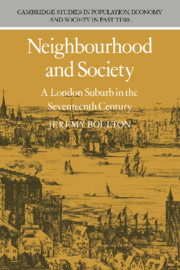Book contents
- Frontmatter
- Contents
- List of figures
- List of tables
- Preface
- Abbreviations
- 1 Introduction
- 2 The demographic background
- 3 Earning a living in early seventeenth-century Southwark
- 4 Wealth and social structure
- 5 Household structure and the household economy
- 6 Power, status and social mobility
- 7 Residential patterns and property ownership
- 8 The dynamics of a local community
- 9 Social relationships in the urban neighbourhood
- 10 The institutional structure of the neighbourhood
- 11 Conclusion: neighbourhood and society in seventeenth-century London
- Bibliography
- Index
3 - Earning a living in early seventeenth-century Southwark
Published online by Cambridge University Press: 19 October 2009
- Frontmatter
- Contents
- List of figures
- List of tables
- Preface
- Abbreviations
- 1 Introduction
- 2 The demographic background
- 3 Earning a living in early seventeenth-century Southwark
- 4 Wealth and social structure
- 5 Household structure and the household economy
- 6 Power, status and social mobility
- 7 Residential patterns and property ownership
- 8 The dynamics of a local community
- 9 Social relationships in the urban neighbourhood
- 10 The institutional structure of the neighbourhood
- 11 Conclusion: neighbourhood and society in seventeenth-century London
- Bibliography
- Index
Summary
The task of reconstructing the occupational profile of one part of London is made the harder by the absence of comparative information for the rest of the capital. The immense physical size of London and the daunting nature of the task involved has restricted work on its occupational make-up. Unlike many towns and cities in pre-industrial England there is no single central source for occupations available. In particular, Freemen's registers (i.e. registers of individuals taking up the freedom of a town or city), which have been used to delineate the occupational structures of some provincial towns, are not extant for London before the later seventeenth century and their representativeness depends on the (as yet unknown) proportion of the adult male population who took up the freedom in later Stuart London. Because of this historians have been forced to nibble at the edges of the problem, either by studying one particular city company or by concentrating on a specific geographical area. Since comparative material is lacking, such studies can give us no real idea of the relative importance of an occupation to the whole of London. Sampling by parish or ward has its drawbacks too, since occupational groups were not spread evenly across the capital. The little that is known of London suggests that certain occupations were often grouped together in specific zones. Hence the concentration of alien silkweaving in Bishopsgate and Spitalfields, dyeing close to the Thames, and gunsmiths around the Tower.
- Type
- Chapter
- Information
- Publisher: Cambridge University PressPrint publication year: 1987

